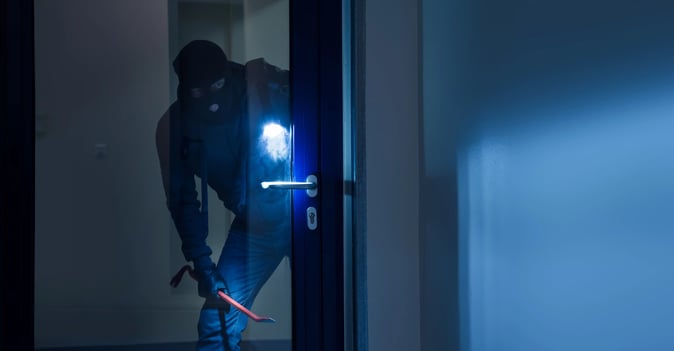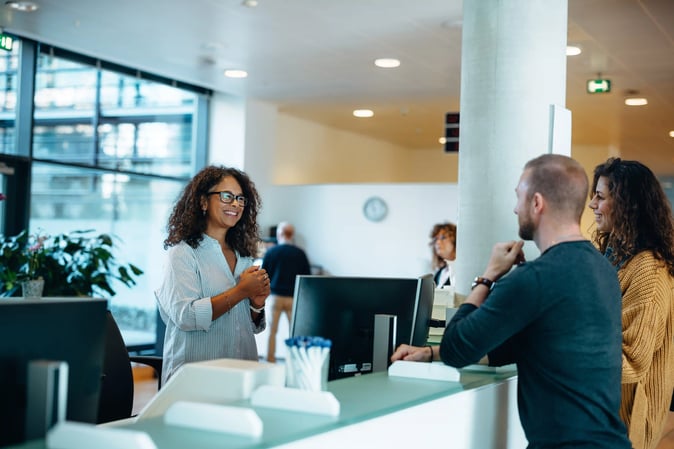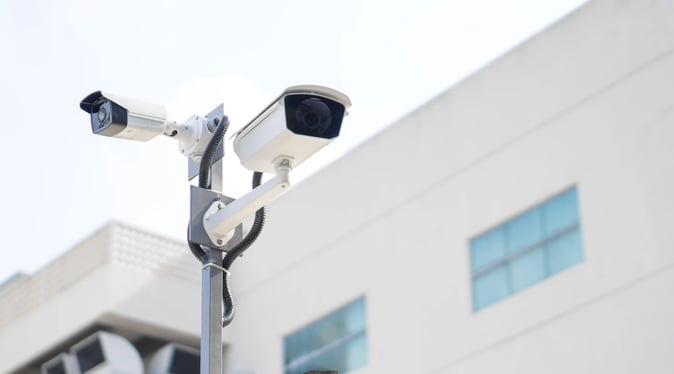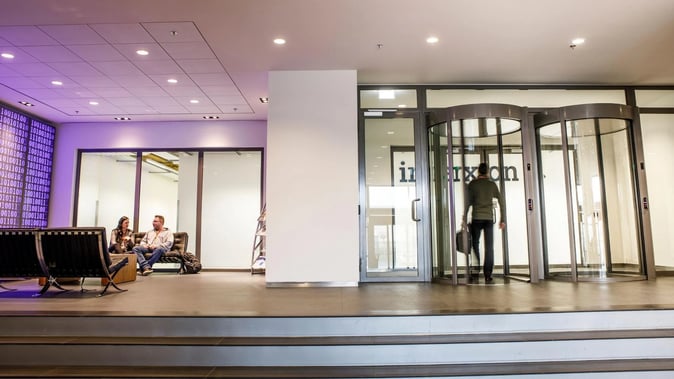For businesses, building management is no longer as simple as it once was. For one, building usage has changed dramatically over the last century — and even more over the last decade.
Covid-19 brought with it a whole host of changes, from remote and hybrid working to the very real threat of illness in the office and staff shortages. And as building usage has evolved, we’re now faced with a more multi-purpose, multi-tenant approach that sees various business types working in the same buildings, and even sharing the same spaces. All of this amounts to more complex security challenges.
Of course, as building use changes, threats don’t stay put — they evolve too. Criminals adapt their mindsets and strategise new approaches, and so develop new threats in the realms of cyber and physical security. While much of the last decade has seen a huge focus on the former, virtual risks posed to businesses, it’s vital we don’t forget to protect against physical security vulnerabilities.
From unauthorised access to theft and vandalism, businesses face a range of security threats that can have significant consequences. Let’s explore the key physical threats to businesses and look at some practical solutions.
1. Unauthorised access and tailgating
By far one of the most prevalent and persistent threats that businesses face comes in the form of unauthorised access.
Unauthorised individuals gaining entry to secure areas can not only compromise the safety of employees and visitors, but also of sensitive information and valuable assets. A common method used by intruders to gain access is tailgating — following closely behind an authorised person to gain access to a restricted area.
Tailgating detection
Solutions like Boon Edam’s speed gates can act as a visual deterrent, detecting tailgating and alerting security personnel of potential breaches.
The Lifeline Speedlane Swing, for example, is best-in-class when space is limited but security is essential. Powered by state-of-the-art technology, the Speedlane Swing reliably and accurately detects tailgating and includes jump-over sensors. This highly effective solution also has the added benefit of reducing the strain on reception and security staff trying to keep track of individual entrances.
In buildings where wide access gates are required (for example, for disabled access or visitors with luggage or deliveries), the Winglock Swing works harmoniously with the Lifeline Series. This wide lane side gate can be fitted with high glass up to 1800mm, acting as the perfect deterrent while remaining sleek and unobtrusive.
Our security doors and mantrap portals offer the highest level of security and not only detect tailgating, but prevent attempts altogether.
To complement physical barriers, it’s also important to provide physical security training for employees. Establishing a physical security policy will remove any uncertainty and empower individuals to do their part.
2. Theft of documents, data, and property
Does your business handle sensitive documents and intellectual property that, if in the wrong hands, could have serious consequences? Most businesses do. Be it client information, employee data, or business insights, lots of forms of data can be used against you.
Preventing information theft
One of the most basic and impactful measures you can take to prevent document theft or the revelation of information is to implement a clear-desk policy. Desks should be regularly cleared, laptops locked, and sensitive documents stored (and eventually shredded) securely.
Integrating access control systems with physical hardware, like speed gates and security doors, will also help prevent unauthorised individuals from entering the workplace and accessing information in the first place. If you have expensive property or data servers in your building, be sure to put layers of access security in place — culminating in a high level of security at the entrance to that area. Biometrics or facial recognition, for example, are pretty foolproof ways to ensure only the right people are admitted.
Not sure what level of security your business needs? Our security solutions page can help.
3. Unaccounted visitors & intruders
At any given time, it’s essential to know who is present in the workplace — not only for physical security, but also in case of a fire or incident. Unaccounted visitors or intruders pose a real security risk as their presence can go unnoticed, which can, in turn, make it challenging to identify and resolve breaches.
Next, you’ll need to choose the right entrance security products based on your security needs.
Tracking & monitoring visitors
Again, access control systems are your best friend here! By providing visitor passes and employee IDs, businesses can maintain a log of entry and verify the presence of authorised personnel.
Our access control system panel, BoonTouch, is a great example of a user-friendly interface that enhances security when paired with physical security barriers. When integrated, BoonTouch allows receptionists or security guards to remotely control all linked security entrances — and lock things down in the event of a breach.
Alongside access control systems, the use and monitoring of security cameras can aid in identifying suspicious activity and persons.
4. Stolen identification & access control breaches
However great they are, access control systems are only effective if individuals use their own identification credentials. Lost or stolen identification cards can undermine the security measures in place.
Educating employees on ID protection
The key here is education. Employees need to understand the importance of protecting their access credentials, cards, and devices.
Emphasise the personal responsibility everyone has when they come into the workspace and encourage them to play their part in enforcing good security practices.
Beyond education, there are adaptations that businesses may need to make to create a more robust ID system. As just one example, ID cards would be much safer (and less easily lost) when worn on lanyards rather than kept loose.
Furthermore, layers of security come in handy here. Assess which areas need to be high-security and which require less stringent measures, and adapt your approach to each. You might decide you’re comfortable with just ID cards being used in the low-requirement areas, but that biometric systems are necessary where protection needs to be stronger.
5. Social engineering attacks
A frightening prospect, many businesses will have heard of the lengths criminals will go to to obtain building access. Social engineering is by far one of the most insidious, particularly given the shift towards more shared working spaces. In the last few years, social engineering incidents have been rising in frequency and severity, with the average organisation facing over 700 attacks per year.
Social engineering involves the manipulation of individuals with access by exploiting human empathy, information, and trust. Criminals may, for example, pose as interviewees, electricians, and stakeholders to get let in — and they’ll put the pressure on to do so.
Combating social engineering
Employee training is one of the biggest shields against this physical security threat.
Give employees some examples of how a social engineer may approach them, and empower them to respond correctly. One of the things criminals rely on is that the victim has no recourse, because the business won’t have a policy in place for admission. You might like to specify, for example, a line they can say — like: “Let me go ahead and confirm your appointment with the front desk. Wait there.”
Genuine visitors won’t be offended if they’re spoken to in a way that’s friendly and direct. Instead, they’ll probably be impressed by your organisation and commitment to security.
6. Threats to biosecurity
Covid-19 taught us that biosecurity is an important aspect of any business’ building policy. Put simply, biosecurity risk refers to the potential dangers posed by harmful biological or biochemical substances that can impact the well-being of people.
The recent pandemic caught many businesses off-guard. They were either not prepared or lacked the appropriate security protocols that could assist with the management of biothreats.
Hands-free access and touchless solutions are surprisingly effective at reducing and limiting the spread of infection. Another great way to mitigate biosecurity risk comes in the form of thermal imaging. You may have used these small devices that, strategically placed at entry points, give you a temperature reading before gaining access — nifty!
7. Terrorism
The threat of terrorist attacks is undoubtedly one of the most globally-reaching security concerns. For most businesses, the likelihood they will face any threat of this kind is, of course, low. On the other hand, Government buildings, high-profile offices, and buildings frequented by politically exposed individuals are statistically more likely to be the target of terror threats.
Regardless, it’s a good idea for most businesses to put protective measures in place.
Managing the risks of terrorism and rioting
Essential to this is the implementation of ‘identification’ capabilities — like access control and internal CCTV cameras with video analytics technology. Systems that have a lockdown capability can be incredibly effective in the event of an incident.
Once more, staff awareness and an understanding of what to report (like unattended items) and to whom can neutralise potential threats.
Crucially, burglar and bullet-resistant entrances and glass offer unparalleled protection against incidents of terror and rioting. Security doors with burglar resistance generally fall into one of two categories:
- RC2 — offering 3 minutes of resistance time, these provide protection against casual criminals using simple tools.
- RC3 — offering 5 minutes of resistance time, these provide protection against more experienced criminals using leverage tools.
As for the threat of gunfire, bullet-resistant glass is the gold standard in risk reduction. Under European regulations, EN 1063 regulates the testing of bullet-resistant glass spanning 9 different ballistic classes — from BR1 to BR7. 1 to 4 covers weapons ranging from sport rifles to pistols and revolvers; the higher classes involve military assault rifles and the like.
Boon Edam’s Burglar Resistance packages
Our Tourlock revolving doors and Circlelock portals can be upgraded with burglar-resistant glass and extra door reinforcements for ultimate security.
When it comes to vandalism and burglar/attack prevention, we’ve got you covered there too. All of our doors come equipped with vandal-resistant glass as standard, which is effective at stopping a burglar’s first attempt at breaking in — this is often enough to deter them. For protection against manual tool attacks and more determined attempts, our Burglar Resistant Package ensures heavy blows (like from an axe or heavy object) don’t penetrate the glass, and that hand-held tools are rendered useless against the door.
You can read more about our Protection Packages here.
Martyn’s Law
On the 19th December 2022, the UK Government announced details of the Protect Duty, also known as ‘Martyn’s Law’.
The draft bill aims to enhance national security and reduce the risk of terrorism in public spaces and venues. High-risk locations are required to consider the threats they face and implement mitigation measures appropriate to their size and the activities that take place there.
Venues will be classified under either a standard or enhanced tier which will define their duties, such as:
- Completing training
- Raising awareness and disseminating information amongst staff
- A risk assessment
- Creating a security plan.
All of these measures are to be enforced by an inspectorate — but the important thing to know at this stage is that businesses bound to the duty will be supported through the process. Dedicated platforms have been established to help responsible businesses; see ProtectUK’s page on Martyn’s Law for more details.
Taking a holistic approach to physical security
The threat landscape is continually evolving — but so is our approach. More and more businesses are thinking about security holistically, as a seamless integration of frameworks that combat both cyber and physical threats.
By implementing secure entrances, access controls, visitor management protocols, and comprehensive training programmes, businesses will significantly enhance their physical security (and cybersecurity, to some extent, in turn).
If you’re looking to up the ante of your building’s security, Boon Edam is here to help. For 150 years, we’ve been securing businesses across the globe and putting minds at ease through our innovative approach to entrance technology. Whether you need tailgate-preventing speed gates, access-controlled revolving doors, or high-security mantrap portals, we’ve got you covered.
Discover more of our security products and get in touch!




.jpg)